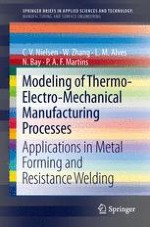Modeling of Thermo-Electro-Mechanical Manufacturing Processes with Applications in Metal Forming and Resistance Welding provides readers with a basic understanding of the fundamental ingredients in plasticity, heat transfer and electricity that are necessary to develop and proper utilize computer programs based on the finite element flow formulation.
Computer implementation of a wide range of theoretical and numerical subjects related to mesh generation, contact algorithms, elasticity, anisotropic constitutive equations, solution procedures and parallelization of equation solvers is comprehensively described.
Illustrated and enriched with selected examples obtained from industrial applications, Modeling of Thermo-Electro-Mechanical Manufacturing Processes with Applications in Metal Forming and Resistance Welding works to diminish the gap between the developers of finite element computer programs and the professional engineers with expertise in industrial joining technologies by metal forming and resistance welding.
